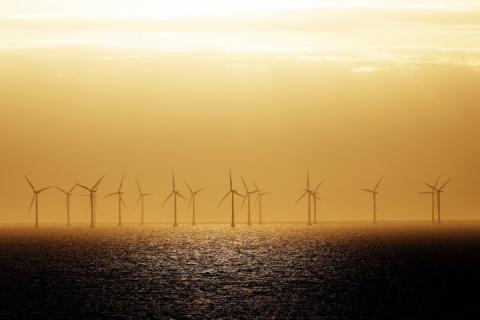Wind power in the U.S. has grown significantly over the last decade, with Americans using three times as much wind power as seven years ago and wind now provides about 4.5 percent of the nation’s electricity.
The U.S. Department of Energy believes those numbers can grow a lot more, projecting that wind turbines could supply as much as 35 percent of U.S. electricity by 2050.
That is the conclusion of a new report released Thursday by the DOE. “Wind Vision: A New Era for Wind Power in the United States,” draws a roadmap for how carbon-free wind power can become one of America’s leading sources of energy as the country looks for ways to reduce greenhouse gas emissions to combat climate change.
The report, touted by the Obama administration, says that up to 113 gigawatts of new wind power capacity can be installed nationwide by 2020 and up to 404 gigawatts by 2050. That would be enough electricity to power nearly 100 million homes.
Building that much capacity over the next three decades is an ambitious but attainable goal, the report says. It would mean a 1 percent increase in consumer electricity costs before 2030, shifting to a 2 percent cost savings by 2050 as more wind farms come online. If wind power expands that much, U.S. greenhouse gas emissions can be reduced by about 14 percent.
As wind grows, investments in wind energy would reach as much as $70 billion annually by 2050, at which point the industry would support 600,000 jobs, the report says.
“Wind’s growth over the decade leading to 2014 has been driven largely by wind technology cost reductions and federal and state policy support,” the report says.
The report comes as wind growth has begun to tick upward following a 90 percent decline in development after Congress allowed the Production Tax Credit to expire in 2013, drastically reducing the tax incentive for wind power development.
The report recommends that federal and local governments do what they can to bolster wind’s competitive position in the power market or the existing manufacturing infrastructure will languish and fade over time without support, and an opportunity to reduce greenhouse gas emissions may be diminished.
Already, the U.S. government is opening vast areas of the Atlantic off the New England coast to new wind development, including 742,000 acres of open water near Martha’s Vineyard, Mass., where enough wind turbines could be built to power 1.4 million homes.
The report envisions wind power development occurring in every state at a time when offshore development in the U.S. is far behind European countries, where more than 2,300 turbines in 73 wind farms twirl off the shores of 11 different countries.
Tom Kiernan, CEO of the American Wind Energy Association (AWEA), said in a statement that the report provides the wind industry with aggressive targets to meet, urging lawmakers to support the industry so it can double in size by the end of the decade.
AWEA plans to launch a year-long campaign to convince the public to support wind power.
The “Wind Vision” report, drew an immediate rebuke from some members of Congress who see wind as a bad deal.
“Our country uses about 25 percent of the electricity in the world. Relying on windmills to produce that electricity when nuclear power is available is the energy equivalent of going to war in sailboats when nuclear ships are available,” U.S. Sen. Lamar Alexander, R-Tenn., said in a statement.
Bobby Magill is a Senior Science Writer at Climate Central, focusing on energy and climate change. Prior to joining Climate Central, Magill covered Western energy and environmental issues as a freelance writer for Popular Mechanics and as an award-winning reporter for the Fort Collins Coloradoan newspaper in Fort Collins, Colorado, and the Daily Sentinel newspaper in Grand Junction, Colorado. His work has appeared in USA Today, High Country News, NewWest.net and other publications. His coverage of oil and gas drilling and fracking at the Coloradoan earned a commendation from the Columbia Journalism Review as a "model for other reporters on this beat in the West and beyond." A former Colorado and New Mexico wilderness guide and a South Carolina native, Magill holds a B.A. in Communications with a specialization in Mass Media from the College of Charleston. Email: bmagill@climatecentral.org.


Spread the word